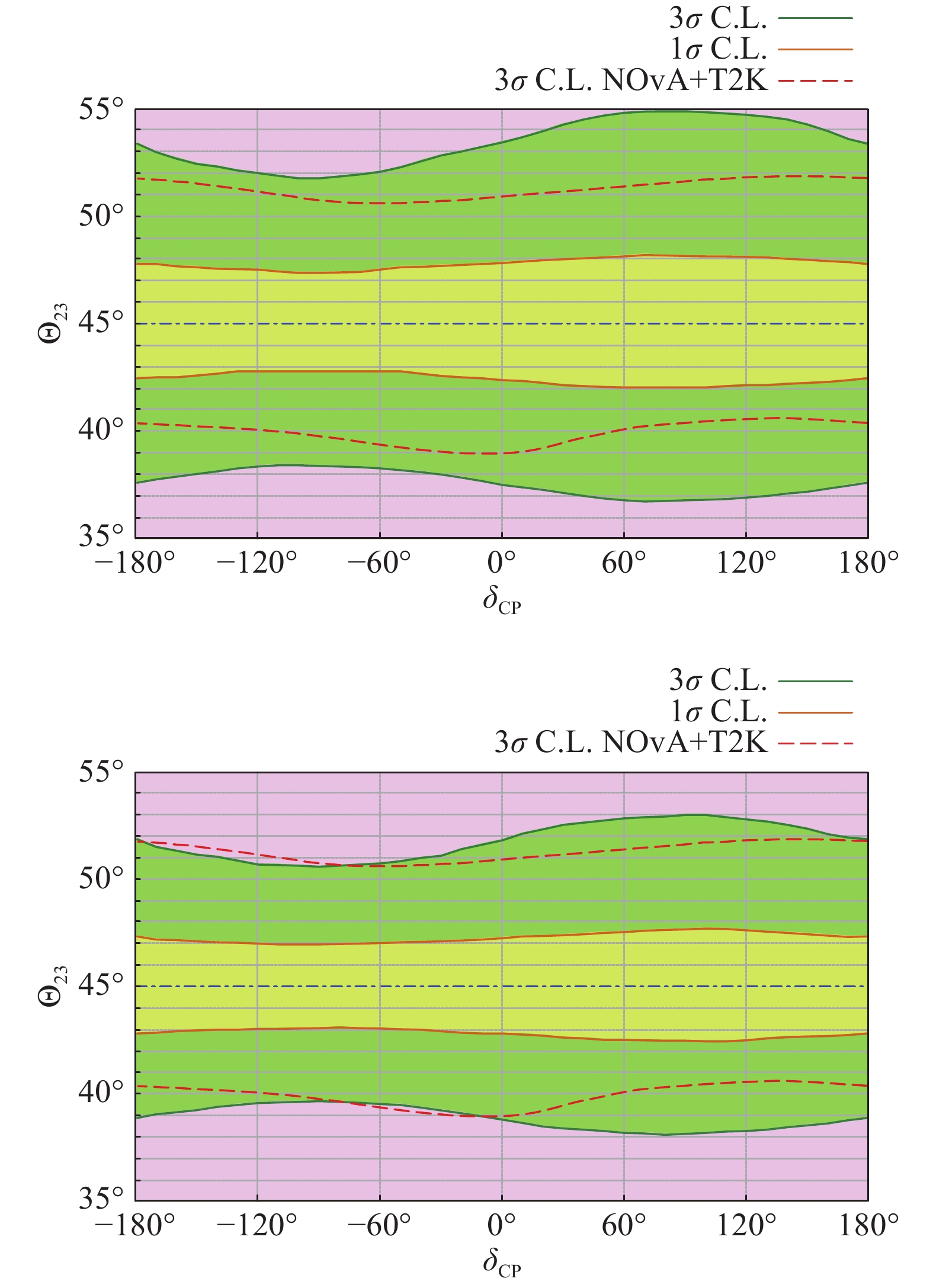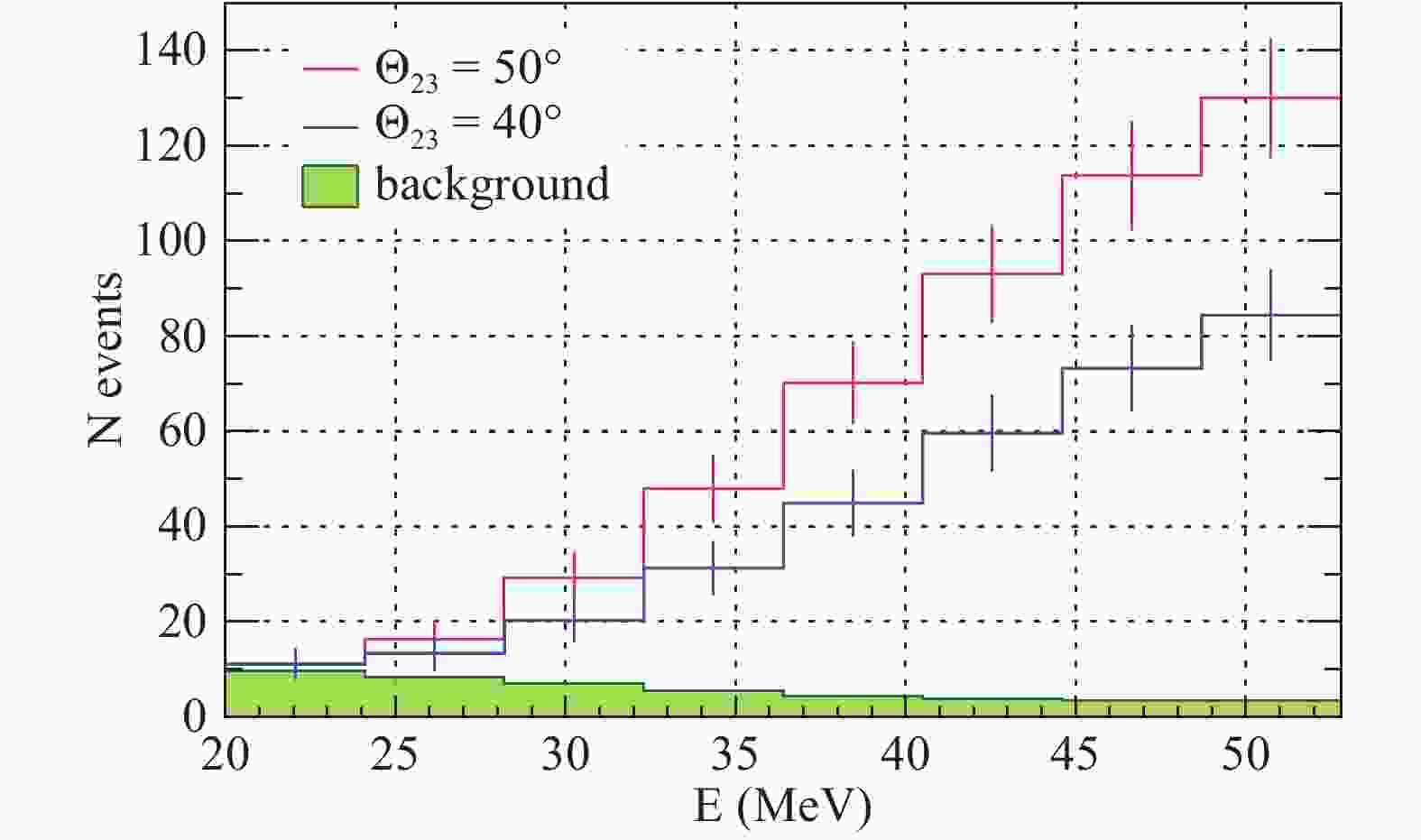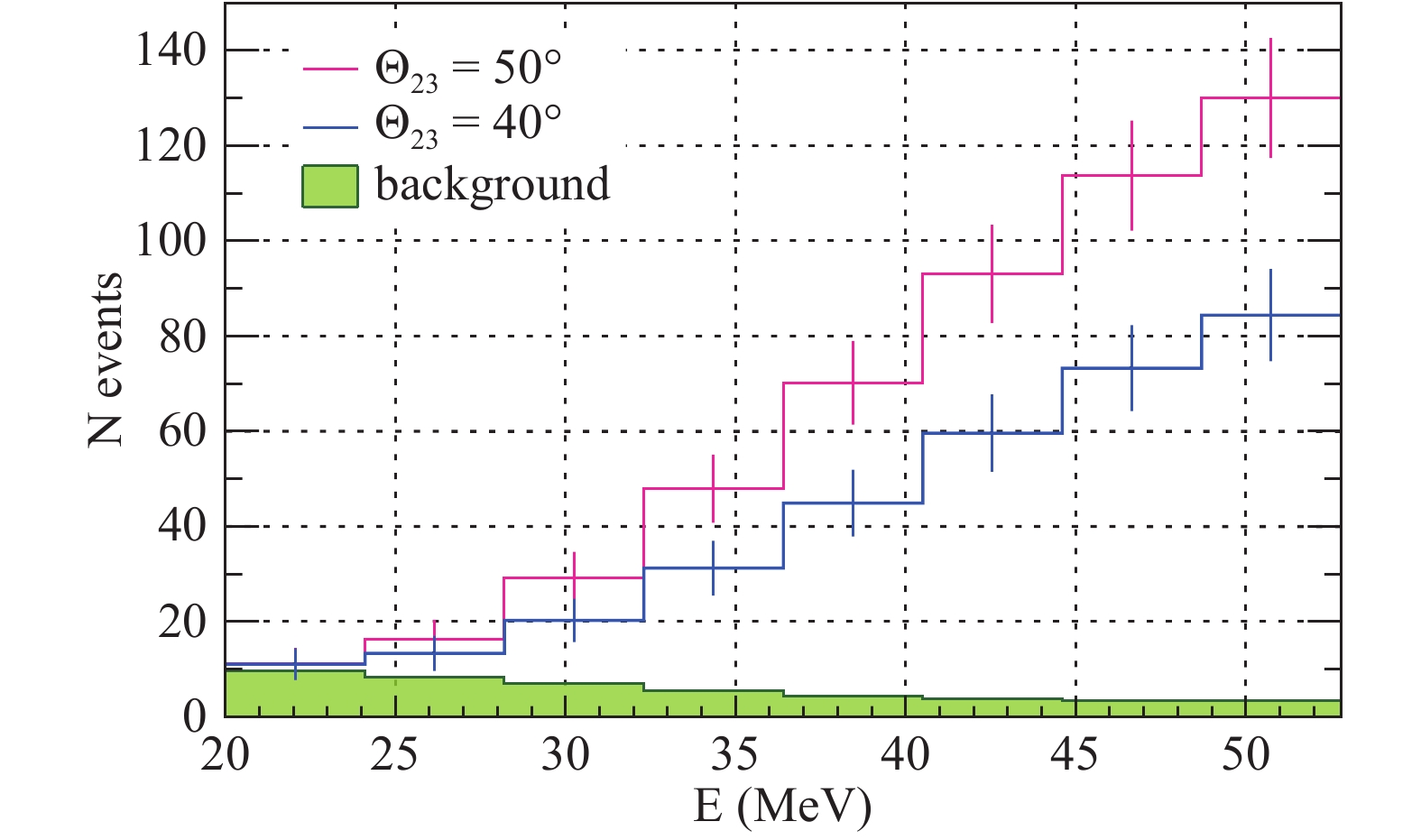-
In the framework of 3-flavor neutrino mixing through Pontecorvo-Maki-Nakagawa-Sakata [1] unitary mixing matrix:
$ {U_{{\rm{PMNS}}}} = \left( {\begin{array}{*{20}{c}} {{U_{{\rm{e1}}}}} & {{U_{{\rm{e2}}}}} & {{U_{{\rm{e3}}}}}\\ {{U_{\mu {\rm{1}}}}} & {{U_{\mu {\rm{2}}}}} & {{U_{\mu {\rm{3}}}}}\\ {{U_{\tau {\rm{1}}}}} & {{U_{\tau {\rm{2}}}}} & {{U_{\tau {\rm{3}}}}} \end{array}} \right), $

(1) $ \sin^2(\Theta_{23}) $ and$ \cos^2(\Theta_{23}) $ can be expressed in the standard parametrization as:$ \sin^2(\Theta_{23})=\frac{|U_{\rm \mu3}|^2}{1-|U_{\rm e3}|^2}, \;\; \cos^2(\Theta_{23})=\frac{|U_{\rm \tau3}|^2}{1-|U_{\rm e3}|^2}. $

It is clear that if
$ \Theta_{23} $ =45°, then mixing between$ \nu_{\mu} $ and$ \nu_{\tau} $ becomes maximal. This would indicate symmetry between the$ \nu_e\to\nu_{\mu} $ and$ \nu_e\to\nu_{\tau} $ oscillation processes. The octant problem refers to the degeneracy between$ \Theta_{23} $ and$ \pi/2 -\Theta_{23} $ , when the mixing angle enters in the oscillation probability as a term within$ \sin(2\Theta_{23}) $ . However, the degeneracy between the lower octant (LO) and the upper octant (UO) can be eliminated if a measurement is sensitive to terms with$ \sin(\Theta_{23}) $ or$ \cos(\Theta_{23}) $ . Until recently, there was a quite large uncertainty in the measurements of$ \sin^2(\Theta_{23}) $ :$ \sin^2(\Theta_{23})=0.35-0.65 $ (90%C.L.) for normal hierarchy (NH), and$ \sin^2(\Theta_{23})=0.34-0.67 $ (90%C.L.) for inverted hierarchy (IH), from the combined analysis of the MINOS experiment [2]. T2K reported the best fit value of$ \sin^2(\Theta_{23})=0.532 $ (NH) and$ \sin^2(\Theta_{23})=0.534 $ (IH) with smaller uncertainty and consistent with hypothesis of maximal mixing [3]. Recent data from the NO$ \nu $ A experiment favors$ \Theta_{23} $ in either LO or UO, and disfavors maximal mixing at 0.8$ \sigma $ significance [4].Since the leading approximation of oscillation probability for reactor experiments does not depend on the mixing angle
$ \Theta_{23} $ , the current scientific program of JUNO [5] will not allow for a solution to the problem of octant degeneracy. However, precise measurements of$ {\bar{\nu }}_{e} $ appearance from$ {\bar{\nu }}_{\mu} $ disappearance could provide a possibility to partially resolve this degeneracy. -
The full description of our proposal is presented in [6], which is based on the DAE
$ \delta $ ALUS experiment project [7]. It is worthwhile to summarize the main aspects of the previous research. We suggest using the appearance channel for electron antineutrinos from muon antineutrinos. In the framework of standard three neutrino mixing theory the oscillation probability without matter effect can be expressed as [8]:$ \begin{split} &P({{\bar \nu }_\mu } \to {{\bar \nu }_e}) \!=\! {\sin ^2}{\theta _{23}}{\sin ^2}2{\theta _{13}}{\sin ^2}{\Delta _{31}} \!+\! {\cos ^2}{\theta _{23}}{\sin ^2}2{\theta _{12}}{\sin ^2}{\Delta _{21}}\\ &\quad + \sin 2{\theta _{13}}\sin 2{\theta _{23}}\sin 2{\theta _{12}}\sin {\Delta _{31}}\sin {\Delta _{21}} \cdot \cos ({\Delta _{31}} - {\delta _{{\rm{CP}}}}), \end{split} $

(2) where
$ \Delta_{ij}=\Delta m_{ij}^2\cdot L/(4E_{\nu}) $ ;$ \Delta m_{ij}^2 $ – the neutrino mass squared difference;$ L $ – the distance between source and detector;$ E_{\nu} $ – neutrino energy;$ \delta _{\rm{CP}} $ – Dirac phase of CP violation. The source of$ \bar{\nu}_\mu $ is a three-body decay of$ \mu^+ $ from decay at rest of stopped$ \pi^{+} $ , which are produced by a superconducting cyclotron [9]. The contribution to electron antineutrino spectrum is around$ 10^{-4} $ from$ \pi^{-} $ , which are created together with$ \pi^{+} $ [7]. Two cyclotrons (near and far) will be located at distances of 1.5 km and 20 km, respectively. The power of the near cyclotron is 1 MW. It is needed as a flux monitor. There are two options for the power of the far cyclotron: 5 MW and 10 MW. We are planning to use JUNO as a liquid scintillator detector, which has a total mass of 20 kt. The expected exposure time of the experiment is 10 years. NH is assumed, because at a distance of 20 km the experiment is insensitive to mass hierarchy.The estimated IBD-event spectrum as a function of energy is depicted in Fig. 1. It is clear that the neutrino rate increases with mixing angle
$ \Theta_{23} $ . -
Event rate analysis is based on statistical treatment of the expected IBD signal rate inside the detector. Initial muon antineutrinos have a continuous spectrum with an endpoint of 52.8 MeV. In order to exclude a significant part of the atmospheric background, we chose an energy window between 20 and 52.8 MeV. However, this is not sufficient to disregard the background completely.
The current statistical analysis is devided in two parts. The first part concerns the sensitivity to octant degeneracy; the second part is about the precise measurement of
$ \Theta_{23} $ . -
We follow the so-called classical method of calculating a confidence level. This method is based on the calculation of a
$ \Delta\chi^2 $ function, which, as Wilks's theorem predicts [10], should follow a chi-square distribution. The number of degrees of freedom can be calculated as the difference between the degrees of freedom of initial chi-square functions. Usually, this number is equal to the quantity of estimating parameters. In our case, there is only one parameter –$ \Theta_{23} $ .A
$ \chi^2 $ distribution with one degree of freedom has the same distribution as the square of a single normally distributed variable [11]. Therefore, standard Gaussian confidence levels 1$ \sigma $ (68.3%), 2$ \sigma $ (95.4%), 3$ \sigma $ (99.7%) etc. correspond to values of$ \chi^2 $ : 1, 4, 9 etc.In general, the sensitivity to octant degeneracy can be calculated by minimization of a
$ \Delta\chi^2 $ function, which is given by:$ \Delta\chi^2=|\chi_{\rm min}^2(90^\circ -\Theta_{23})-\chi_{\rm min}^2(\Theta_{23})|, $

(3) where “min” means that both chi-square functions
$ \chi^2(90^\circ -\Theta_{23}) $ and$ \chi^2(\Theta_{23}) $ have to be minimized in their parameter spaces;$ \Theta_{23} $ is a scanning parameter, which is fixed for each iteration of an MC cycle. In our case, the chi-square function has only one minimum, which is close to the test-true value of$ \Theta_{23} $ . In the opposite octant this function always increases. Consequently we need to redefine the$ \Delta\chi^2 $ function as:$ \Delta\chi^2=|\chi_{\rm min}^2(45^\circ )-\chi_{\rm min}^2(\Theta_{23})|, $

(4) where 45° corresponds to a border between two octants.
We use the chi-square function presented in [12, 13].
$ \chi^2(\Theta_{23})=\chi^2_{{\rm pull}}+\chi^2_{{\rm prior}}, $

(5) where the pull-term includes Poisson statistics, and takes into account the background and flux normalization. Additional Gaussian penalties are also added.
$ \chi^2_{{\rm pull}}=2\sum_{i=1}^{N_b}\Big{[}\mu_i-n_i+n_i\cdot\ln\frac{n_i}{\mu_i}\Big{]}+\frac{s^2}{\sigma^2_s}+\frac{b^2}{\sigma^2_b}. $

(6) Here,
$ N_b $ – is the total number of bins in the histogram;$ \mu_i $ – predicted counts in the$ i $ -th bin;$ n_i $ – observed counts in the$ i $ -th bin;$ s $ and$ b $ – so-called nuisance parameters for signal and background, respectively;$ \sigma_s $ and$ \sigma_b $ – systematic errors for signal and background counts.$ \mu_i $ is given by :$ \mu_i=N_s^i\cdot(1+s)+N_{bkg}^i\cdot(1+b), $

where
$ N_s^i $ and$ N_{bkg}^i $ are the number of counts in the$ i $ -th bin for signal and background, respectively. The prior-term in equation (5) corresponds to uncertainties of oscillation parameters and can be written as:$ \chi^2_{{\rm prior}}=\sum_{j=1}^{N_p}\frac{(\eta_j-\eta_j^o)^2}{(\delta\eta_j)^2}, $

(7) where
$ N_p $ – is the number of oscillation parameters;$ \eta_j $ –$ j $ -th oscillation parameter;$ \eta_j^o $ – best fit value of$ \eta_j $ ;$ \delta\eta_j $ – one sigma error of$ \eta_j^o $ . -
The estimation of the accuracy of measurement for the current best fit value of
$ \Theta_{23} $ can be obtained by minimizing the chi-square function (5) in the whole parameter space. It should be emphasized that from recent experimental data the best fit value of$ \Theta_{23} $ is split between LO and UO [14]. Consequently, we use two values of$ \Theta_{23} $ in the calculation of precision.Further, we give a set of oscillation parameters and their uncertainties taken from PDG in Table 1.
${ \eta_j }$ 

${ \Delta m_{21}^2}$ ·10−5/eV2

${ \Delta m_{32}^2}$ ·10−3/eV2

${ \sin^2(\Theta_{12}) }$ 

${ \sin^2(\Theta_{23}) }$ 

${ \sin^2(\Theta_{13})}$ ·10−2

${ \eta_j^o }$ 

7.53 2.51 0.307 ${ ^{\rm0.597 (UO)}_{\rm0.417 (LO)} }$ 

2.12 ${ \delta\eta_j }$ 

0.18 0.05 0.013 0.026 0.08 Table 1. The list of oscillation parameters and their uncertainties from PDG [14]. Most are used in the prior-term of the chi-square function in our calculations, except the parameter of interest –
$ {\Theta_{23} }$ . The normal hierarchy is assumed. -
The expected electron antineutrino event spectra at a distance of 20 km were simulated using the Monte-Carlo method including oscillations. The energy resolution of the JUNO detector is 3% per MeV. The beam power of the far cyclotron is 5 or 10 MW with systematic flux uncertainty
$ \sigma_s $ =2%, which includes the uncertainties of shape and normalization. We treat neutral current events (NC) as background. The initial estimation gives 439 NC events for an exposure time of 200 kt·year with a duty factor of 33%. Using the technique from [15], which is based on the signal coincidence and pulse shape discrimination, this background can be significantly reduced, to 33 NC events. Adding also fast neutron and charge current atmospheric events, the total background equals 45 events. This number is used in simulations with systematic uncertainty$ \sigma_b $ =5%.To investigate the sensitive region of octant degeneracy, 1k MC “fake” experiments were calculated for each sample with particular fixed values of
$ \delta_{\rm CP} $ . We did not apply any constraints to the parameter$ \Theta_{23} $ . Both parts of$ \Delta\chi^2 $ in equation (3) were minimized using the ROOT package Minuit [16, 17]. Finally, the sensitivity region was calculated as defined in section 2.2.1.In order to evaluate the potential of JUNO to accurately measure the mixing angle
$ \Theta_{23} $ , 5k MC “fake” experiments were simulated for each sample with a particular fixed value of$ \delta_{\rm CP} $ . The chi-square function (5) was minimized in the entire parameter space. A histogram was then filled with the extracted values of$ \Theta_{23} $ . The shape of the histogram is Gaussian, since we assumed that all parameter uncertainties have Gaussian distribution. The 1$ \sigma $ error of$ \Theta_{23} $ was obtained as a standard deviation of the aforementioned histogram. This procedure was repeated for the whole range of CP-phase, from$ -\pi $ to$ \pi $ . -
Experimental sensitivity to octant degeneracy is depicted in Fig. 2. The yellow area shows the 68.3% confidence interval, within which the experiment is insensitive to octant degeneracy. The green area shows the insensitive region with confidence level 99.7%.

Figure 2. (color online) The sensitive area for determining the octant as a function of
${ \delta_{\rm CP} }$ assuming an exposure time of 200 kt·year. The top panel corresponds to a 5 MW source, the bottom panel –10 MW. The yellow area corresponds to insensitivity with 68.3% C.L. The green area corresponds to insensitivity with 99.7% C.L. The pink area is sensitive to the octant with a significance of more than 3${ \sigma }$ . Dashed red lines show 99.7% C.L for the combined analysis of T2K and NO${ \nu }$ A presented in [18].In the pink area the octant can be determined with a significance of more than 3
$ \sigma $ . As can be seen, the sensitivity to octant is better for negative values of$ \delta_{\rm CP} $ . For these values, a 5 MW cyclotron can distinguish the octant if the mixing angle$ \Theta_{23} $ is outside the range 38.5°-52.9°. A 10 MW cyclotron can measure the octant if$ \Theta_{23} $ is outside 39.7°-50.8°. Therefore, higher statistics leads to an improvement of the sensitivity. The result for the 10 MW case is slightly worse than the expected result from the combined analysis of T2K+NO$ \nu $ A.Figure 3 gives a quantitative estimation of the uncertainty for two possible values of
$ \Theta_{23} $ as a function of$ \delta_{\rm CP} $ . The top row corresponds to$ \sin^2(\Theta_{23})= 0.597 $ and the bottom row to$ \sin^2(\Theta_{23})= 0.417 $ .The wave behavior of curves in Fig. 3 can be explained by the maximum of the probability function (2) for
$ \delta_{\rm CP}=\pi/2 $ and the minimum for$ \delta_{\rm CP}=-\pi/2 $ . As can be seen in Fig. 3, the main uncertainty comes from oscillation parameters. Our estimation shows that the dominant uncertainty comes from the mixing angle$ \Theta_{13} $ . The influence of the background is quite small, especially for higher statistics with a 10 MW source. Statistically, the improvement of the results is possible only with a 10 MW source. However, in reality only the LO values can improve the result in the case of a negative CP-phase.
Figure 3. (color online) Measurement accuracy of the mixing angle
${ \Theta_{23} }$ . The top row is for${ \sin^2(\Theta_{23})= 0.597 }$ and the bottom for${ \sin^2(\Theta_{23})= 0.417 }$ . Two values of the power of the far cyclotron are assumed. Dashed red lines correspond to the current value of the relative error${ \sin^2(\Theta_{23}) }$ from PDG, where${ \varepsilon(\sin^2(\Theta_{23})= 0.417) }$ =6.24% and${ \varepsilon(\sin^2(\Theta_{23})= 0.597) }$ =4.36%. -
The present work demonstrates another application of superconducting cyclotrons for measurements in neutrino physics. The transition channel
$ {\bar{\nu }}_{\mu }{\to }{\bar{\nu }}_{e} $ allows to explore not only the problem of CP violation, but at the same time to realize a precise measurement of$ \Theta_{23} $ and partially resolve the octant degeneracy.It was shown that the distinction between LO and UO is comparable to the combined analysis of T2K and NO
$ \nu $ A , especially for negative values of$ \delta_{\rm CP} $ . Regarding the measurement precision of$ \Theta_{23} $ , the current best fit value can be improved only in the case of a 10 MW source, especially if the mixing angle is in LO. There are two main difficulties with precision measurements: uncertainties in the oscillation parameters and small statistics. The problem of statistics can be alleviated by using a small water detector for monitoring neutrino flux instead of the near cyclotron. This allows to use the far cyclotron in a continuous mode, as proposed for the TNT2K experiment [19].The combination of JUNO and superconducting cyclotrons could be a good alternative to conventional beam experiments. It would allow the measurement of
$ \Theta_{23} $ and$ \delta_{\rm CP} $ in the current scientific program without affecting JUNO's main goals.We would like to extend great thanks to School of Physics, Sun Yat-Sen University, especially to the leader of our neutrino group Prof. Wei Wang for cultivating good working conditions. We also express special gratitude to Dr. Neill Raper for editing of this paper.
Potential of octant degeneracy resolution in JUNO
- Received Date: 2018-11-04
- Available Online: 2019-03-01
Abstract: This work extends the idea of using a cyclotron-based antineutrino source for purposes of neutrino physics. Long baseline experiments suffer from degeneracies and correlations between






 Abstract
Abstract HTML
HTML Reference
Reference Related
Related PDF
PDF




















 DownLoad:
DownLoad: